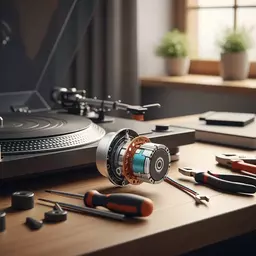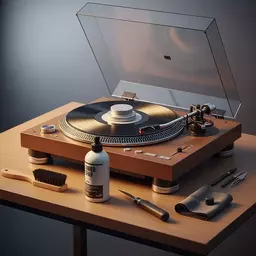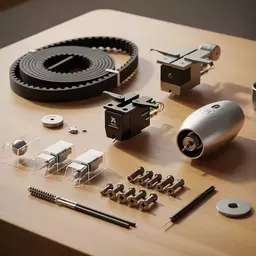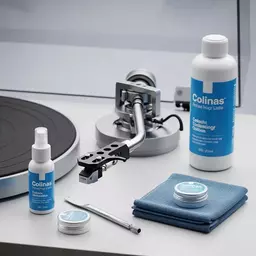Improper Overhang
Stylus extends incorrectly past the headshell, causing tracking issues and distortion.
Did you know that a slight misalignment in your tonearm can drastically diminish your vinyl listening experience? Understanding the nuances of tonearm alignment is crucial for every audiophile. Explore these essential takeaways to refine your setup and elevate your sound quality.
Understanding and correcting these key issues can significantly improve your vinyl playback quality.
Stylus extends incorrectly past the headshell, causing tracking issues and distortion.
Too much or too little force leads to poor sound and record wear.
Stylus not perpendicular to record surface, causing channel imbalance and distortion.
Incorrect tonearm height impacts soundstage and frequency response.
When it comes to enjoying vinyl, accurate tonearm alignment is essential for achieving the best sound quality. Many music lovers don’t realize how much a misaligned tonearm can affect their listening experience. Whether you're a beginner or a seasoned aficionado, understanding these common mistakes can help you unlock the full potential of your analog setup!
At Turntable Repair Australia, I've seen countless turntables that could benefit from a little TLC when it comes to tonearm alignment. So let’s dive into why getting this right is crucial for your vinyl playback.
Accurate tonearm alignment is more than just a technical detail; it’s a cornerstone of great sound. When properly aligned, your tonearm can track the grooves of your records flawlessly, resulting in clearer sound and reduced distortion. However, a misaligned tonearm can lead to issues like uneven wear on your records and unwanted noise. For a deeper understanding of how tonearm alignment impacts sound, consider exploring resources on tracking angle and its effects on audio fidelity.
So, take the time to ensure your tonearm is set up correctly! It might just be the upgrade your vinyl collection has been waiting for.
One of the biggest hurdles in achieving perfect tonearm alignment is recognizing common errors. Here are a few mistakes that I see frequently:
Each of these errors can significantly impact your listening experience. By remaining vigilant about these common pitfalls, you'll be better equipped to troubleshoot and correct them. Further insights into resolving these issues can be found in discussions around tonearm alignment and tracking error solutions.
Overhang refers to how far the stylus extends past the front of the headshell. This small detail can have a big impact on playback. If the overhang is incorrect, it can lead to tracking issues and distortion, especially towards the inner grooves of a record. I always recommend checking the manufacturer's specifications for your specific cartridge and tonearm. Learning about tonearm resonance theory can also provide a broader context for understanding how various adjustments affect sound.
Understanding and adjusting the overhang will help ensure that your records are played back correctly, preserving the integrity of those cherished sounds!
Have you ever faced challenges with tonearm alignment? What tips or tricks have you found most helpful? Share your thoughts below:
When it comes to turntable maintenance, proper tonearm alignment is crucial for achieving the best sound quality from your vinyl records. Throughout this article, we’ve discussed various common mistakes that can lead to subpar playback and how to fix them. Here’s a quick recap of those critical errors and their solutions:
These adjustments can make a world of difference in your listening experience. It’s all about taking the time to fine-tune each component for optimal playback. Remember, a well-aligned tonearm can lead to an immersive analog experience that every music lover craves!
Now that you’re equipped with the knowledge of tonearm alignment, it’s time to put it into practice! Start by regularly reviewing your setup to ensure everything is in check. Here are some best practices to consider:
By following these best practices, you’ll not only enhance your turntable’s performance but also prolong its lifespan. Plus, it’s a great way to foster connections within our vibrant community of analog sound enthusiasts!
Don’t hesitate to reach out! Whether you’re a beginner or a seasoned pro, we all encounter challenges with our setups. At Turntable Repair Australia, we're here to support you on your journey. Share your stories, questions, and successes with us! Together, we can keep the love for vinyl alive and thriving.
If you find yourself facing a particularly tricky issue, remember, I’ve been through the wringer with turntable repairs myself. There’s no shame in asking for help! Reach out, and let’s ensure your vinyl experience is as rich and rewarding as it should be.
Here is a quick recap of the important points discussed in the article:

 Are you ready to elevate your turntable's performance? Understanding the nuances of motor replacemen
Are you ready to elevate your turntable's performance? Understanding the nuances of motor replacemen
 Have you ever wondered how a little maintenance can dramatically enhance your turntable's performanc
Have you ever wondered how a little maintenance can dramatically enhance your turntable's performanc
 Have you ever found yourself frustrated with a turntable that just won't play right? The good news i
Have you ever found yourself frustrated with a turntable that just won't play right? The good news i
 Have you ever considered how the condition of your tonearm affects the music you love? Proper tonear
Have you ever considered how the condition of your tonearm affects the music you love? Proper tonear